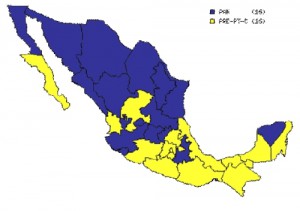The Mexican 2006 Presidential election was very close. Felipe Calderon of the center-right PAN party garnered 35.89% of the vote to barely edge out Lopez Obrador of the leftist PRD party, who got 35.33%. Roberto Madrazo of the left-center PRI party was a distant third with 22.23% of the vote.
What is amazing is that while the margin of overall victory was very small, only 0.56%, the votes for the two leading candidates were extremely lopsided within Mexico’s 32 states. In 17 of the 32 states, the winner got over twice as many votes as the other. In only three states was the spread less than 10%. Thus, the colors on the election map below are very solid. Interestingly, the PRI party which had an iron grip on Mexican politics for seven decades up until 2000 did not win in a single state.
It is also very interesting that voting behavior exhibited a strong north-south pattern. In the 2006 Presidential election, 14 of 17 northern states voted for Calderon of PAN (blue on the map), while 13 of 15 southern states voted for Obrador of PRD (yellow on the map).
It is not surprising that the more conservative, pro Catholic PAN party appealed to the wealthier, more urban northern voters and staunch Catholic voters in western Mexico. On the other hand, the populist PRD candidate was more appealing to the poorer, more rural southern voters.
Mexico City is the main exception, while it is the most prosperous place in the country it is also the most progressive and left-leaning. It recently approved same-sex marriages as well as legalizing marijuana and abortions.
The other exceptions to the north – south divide raise some interesting questions. Why did so few voters in the northern state Nayarit vote for PAN (18.9%) compared to PRD (41.8%) and PRI (33.7%)? Similarly, why did Baja California Sur favor PRD (43.1%) so convincingly over PAN (34.4%)? Interestingly, Yucatan in the PRD dominated southeast voted overwhelming for PAN (46.2%) compared to PRD (15.9%) and PRI (32.9%). It was closer in the southern state of Puebla where PAN (26.8%) edged out PRD (23.1%).
To explain these few anomalies to the north–south pattern will require a closer look at the political dynamics of these states and the election returns at the municipality level. It will be interesting to see if this strong north–south divide persists in the 2012 Presidential election.

Sorry, the comment form is closed at this time.